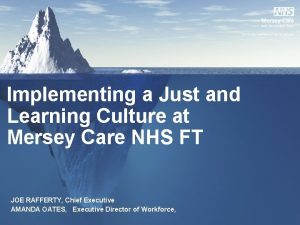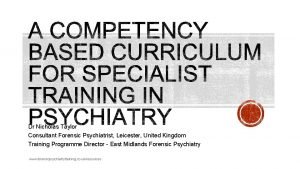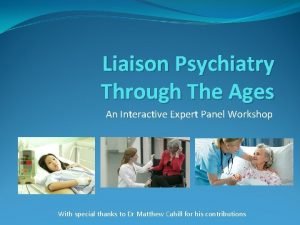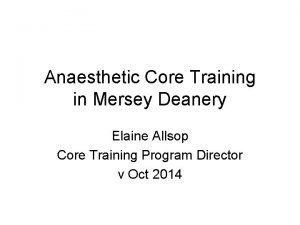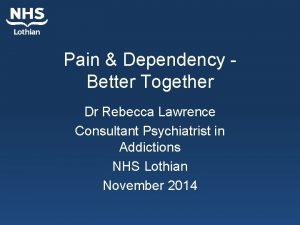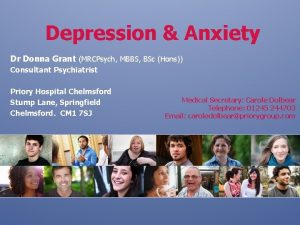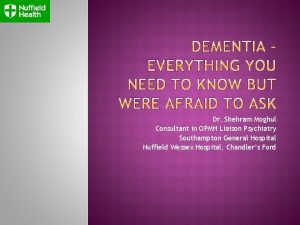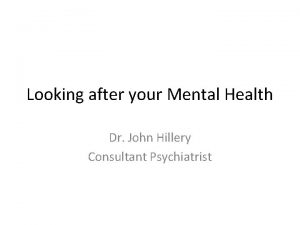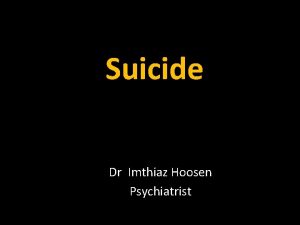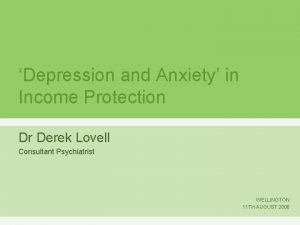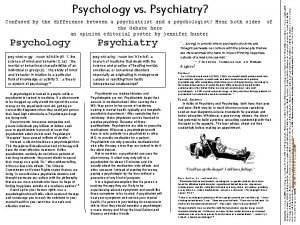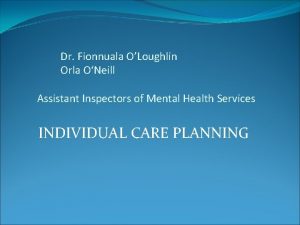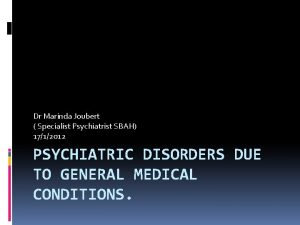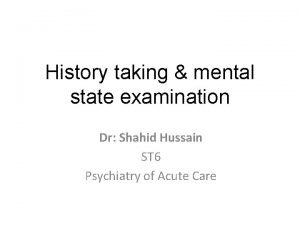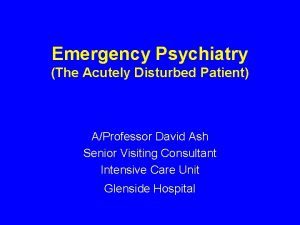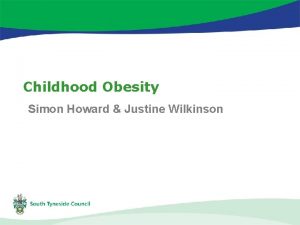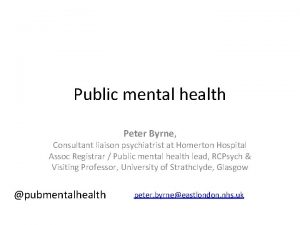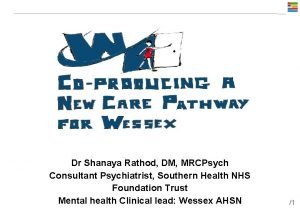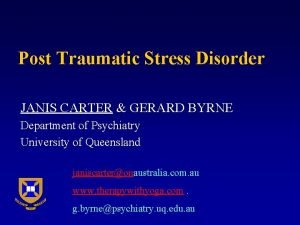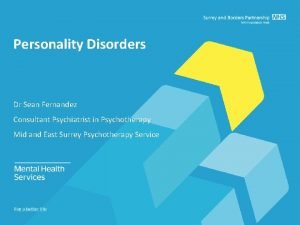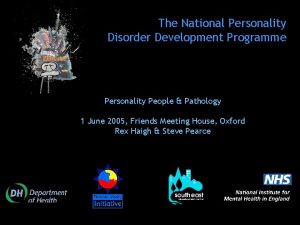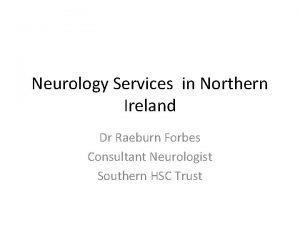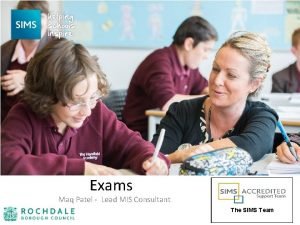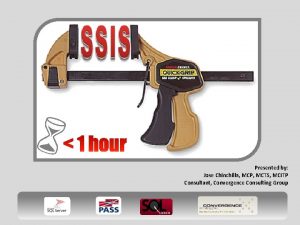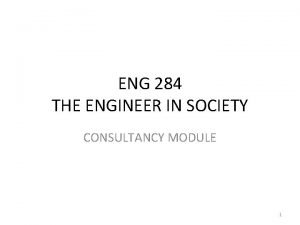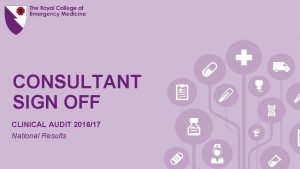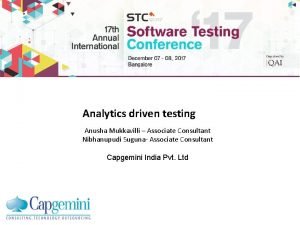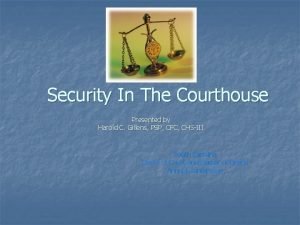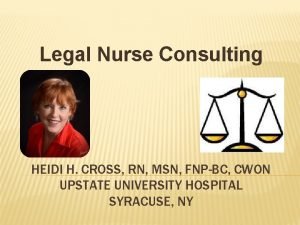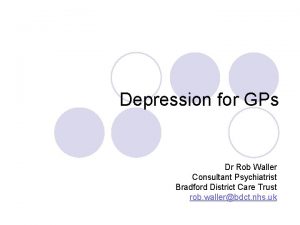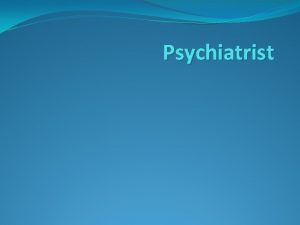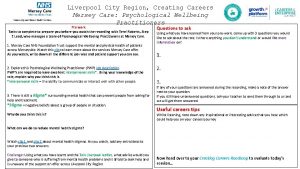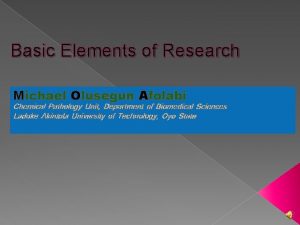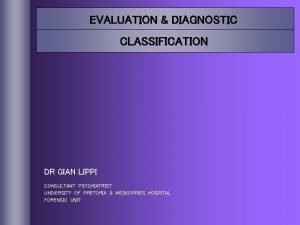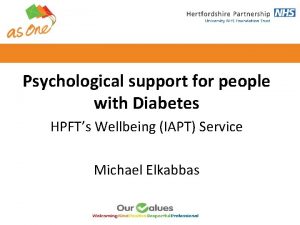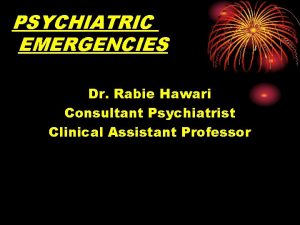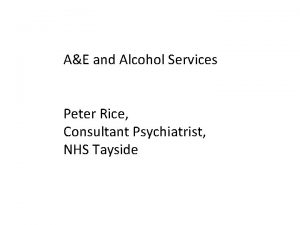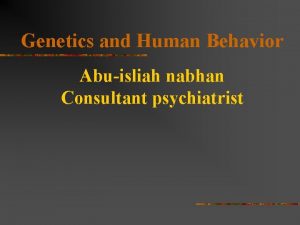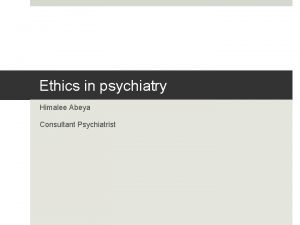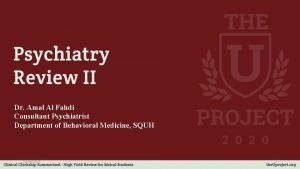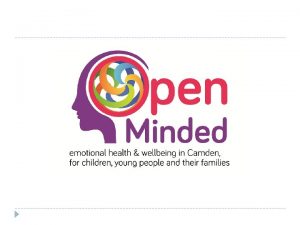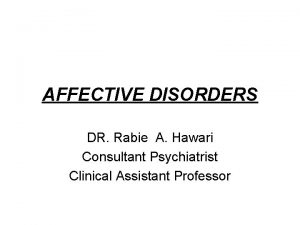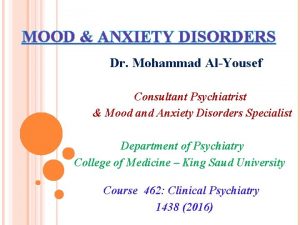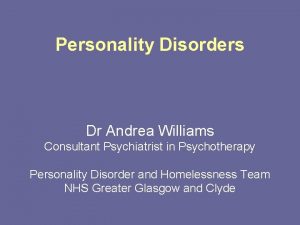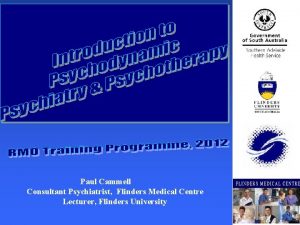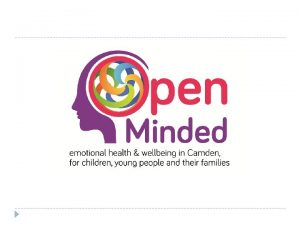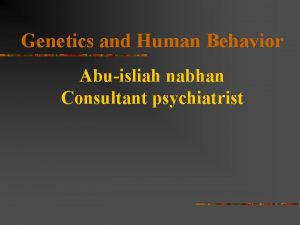Depression Dr Olusegun Popoola Consultant Psychiatrist Mersey Care

































- Slides: 33

Depression Dr Olusegun Popoola Consultant Psychiatrist Mersey Care NHS FT Liverpool olusegun. popoola@merseycare. nhs. uk @drsegunpopoola 15 August 2020

Learning Outcomes • Epidemiology, aetiological factors and risk factors of depression • Symptoms and signs of depression • Screen for depression and identify high risk individuals • Diagnostic classification of depression • To describe the management of mild, moderate and severe depression • Formulate a management plan (short, medium and long term) using the biopsychosocial model • Antidepressants and their side effects

World Health Organisation Unipolar depressive disorder is the third leading cause of disease burden accounting for 4. 3% of the global burden of disease. Lifetime risk is about 15%. Age of onset is becoming younger with 40% of depressed patients 1 st episode <20 yrs

-1 in 10 U. K. population experience depression in any year -More common in women in most age groups. -Common in patients with physical illness. -Increased risk of mortality (1. 4 x) than the general population due to physical health problems and increased risk of suicide.

Etiology of depression • Multifactorial • Biochemical-monoamines theory • Neuroendocrine- HPA axis, sleep/circadian rhythm • Genetic- family, twins and adoptive studies • Social factors • Psychodynamic/life events • Neurocognitive

Criteria for Major Depressive Episode: ICD-10 • Depression can be mild, moderate or severe. • Diagnostic guidelines: symptoms for at least 2 weeks, rule out bipolar affective disorder and organic/substance misuse. • At least 2 of the 3 core symptoms must be met, most days for most of the time: • Low Mood • Loss of interest in pleasure (Anhedonia) • Decreased energy (Anergia)

• In addition to 2 of the 3 core symptoms, additional symptoms would be present. • Number crunching (plus clinical judgement) will determine the level of depression e. g. 2 core and 2 additional symptoms = mild depression, 2 core and 4 additional symptoms = moderate depression, 3 core and at least 5 additional symptoms = severe depression*) • Loss of confidence/self esteem • Guilt – feelings of self reproach • Recurrent thoughts of death , recurrent suicidal ideation • Diminished ability to think or concentrate, or indecisiveness • Change in psychomotor activity (agitation or retardation) • Sleep disturbances (of any type) • Appetite disturbances (decrease or increase)

• Symptoms should be present nearly every day • Cause clinically significant distress or impairment in social, occupational or other important areas of functioning • Not due to the direct physiological effects of a substance (e. g. , a drug of abuse, a medication) or a general medical condition (e. g. , hypothyroidism). • Severe depression may include psychosis. It is usually common (but not essential) for psychotic symptoms to be “mood congruent” i. e. Nihilistic delusions/Persecutory hallucinations etc.

Other Symptoms • Loss of libido • Physical complaints e. g. aches, pains, constipation, increased worry about preexisting medical problems • Diurnal variation of mood • Irritability • Anxiety, worry, dread, catastrophising.

Thoughts • • Negative about self, world and future Helpless, hopeless, Worthless, useless, inadequate Burden, others better off without them

Mnemonic • • • Cognitive symptoms Emotional symptoms Biological symptoms Physical symptoms Psychomotor symptoms SIGECAPS- Sleep, Interest/Pleasure, Guilt, Energy, Concentration, Appetite, Psychomotor activity, Suicide

Differential Diagnosis • • Bereavement/grief reaction Substance induced mood disorder Bipolar disorder Mood difficulties relating to a general medical condition

Medical Conditions with Depressive Symptoms • Neurological disorders: AD, CVD, Infections, Trauma, Epilepsy, Parkingson’s, Wilson’s etc • Endocrine: Cushing’s, Addison’s, Thyroid and hyperthyroid disorders, Vitamin deficiencies • Inflammatory: RA, SLE, TA, Sjogren’s syndrome • HIV/AIDS, Cancers, Cardiopulmonary diseases, MI, post operative states etc

Important Note • Always screen anyone with chronic pain, chronic physical illness, Unexplained physical symptoms, frequent attenders, recent psychosocial stressors and post natal states. • If you suspect depression, always ask about suicidal ideation.

Severity • Number of symptoms • Degree of functional impairment

Mild • Enough symptoms to meet criteria • A person with a mild episode is probably capable of continuing with the majority of their activities • Managed in primary care • Non-Pharmacological treatment

Moderate • Between mild and severe • A person with a moderate episode will probably have difficulties continuing with their ordinary activities • May require secondary care • Combination of treatment

Severe • People with this type of depression have symptoms that are marked and distressing • Suicidal thoughts and acts are common • Psychotic symptoms can appear, such as hallucinations, delusions, psychomotor retardation or severe stupor. • In this case, it is called a severe depressive episode with psychotic symptoms • Usually require secondary services

Severe • May require treatment in hospital • May require detention under mental health act depending on risk

Rating Scales • HAM-D: Clinician rated. 17 -21 items, 20 -30 mins • MADRS: Clinician rated. 10 items, 15 minutes • PHQ-9: Patient rated. Primary care, 9 items, 5 minutes • HADS: Patient rated. Medically ill pts, 14 items, 5 mins • EPDS: Patient rated. PND, 10 items, 20 minutes

Bio-Psychosocial model • Biological • Psychological • Social • • • Presenting Predisposing Precipitating Perpetuating Protective

Biological (Medications) • Small difference in efficacy among antidepressants. Consider safety, tolerability, simplicity of use, comorbid conditions, potential interactions etc • Newer generation are generally safer and better tolerated. Recommended as first line.

Antidepressants are: Effective Not addictive Not known to loose their efficacy over time Not known to cause new long term side effects • Need to be continued at treatment dose • •

• New generation: • Selective Serotonin Reuptake Inhibitors • Serotonin and Noradrenaline Reuptake Inhibitors • Noradrenergic and Specific Serotonergic Antidepressant • Others: SARI, NDRI, NARI, MA • Older generation: TCA and MAOI

Side Effects • SSRI: GI symptoms, CNS symptoms, Drowsiness, dry mouth, Sexual SE • SNRI: Same as above • Nas. SA: Sedation, weight gain • TCA: Anticholinergic, antihistaminergic, CVS, GI, CNS, Sexual SE • MAOI- irreversible- hypertensive crisis from tyrosinase reaction, -reversible-CNS, GI SE

Augmentation • • Antipsychotics Lithium Thyroxine Addition of a second antidepressant

Key Points • A single episode of depression should be treated for at least 6 -9 months after remission • The risk of recurrence is high and increases with each episode • Multiple episodes may require treatment for years • The chances of staying well are greatly increased by taking antidepressants

Antidepressant discontinuation Must not be stopped abruptly May lead to unpleasant discontinuation effects Confers higher risk of relapse Reduced slowly under supervision of a doctor May have discontinuation effects however slowly reduced • FINISH- Flu-like symptoms, Insomnia, Nausea, Imbalance, Sensory disturbances, Hyperarousal/agitation • • •

Physical Therapy • ECT is used only to achieve rapid and short-term improvement of severe symptoms after an adequate trial of other treatment options has proven ineffective and/or when the condition is considered to be potentially life-threatening, in individuals with severe depressive illness and catatonia • Other physical tx: Transcranial MS, VNS, Deep Brain Stimulation, Wake therapy, light therapy

Psychological Counselling Cognitive Behavioural Therapy Mindfulness Interpersonal Therapy Groups such as self help, self–esteem, self confidence. • Anxiety Management • Relaxation • • •

Social • • • Exercise Sign-Posting Housing Finances Social services

All the very best in your exams

Resources • Royal College of Psychiatrists http: //www. rcpsych. ac. uk • NICE https: //www. nice. org. uk/guidance/cg 90/chap ter/1 -guidance • MIND http: //www. mind. org. uk
 Mersey care just culture
Mersey care just culture Consultant forensic psychiatrist
Consultant forensic psychiatrist Expert in consultant liaison psychiatrist
Expert in consultant liaison psychiatrist Mersey frca course
Mersey frca course Primary care secondary care tertiary care
Primary care secondary care tertiary care Dr rebecca lawrence psychiatrist
Dr rebecca lawrence psychiatrist Donna grant psychiatrist
Donna grant psychiatrist Dr shehram moghul
Dr shehram moghul Dr john hillery psychiatrist
Dr john hillery psychiatrist Dr hoosen psychiatrist
Dr hoosen psychiatrist Dr derek lovell psychiatrist
Dr derek lovell psychiatrist Psychologist vs psychiatrist
Psychologist vs psychiatrist Dr fionnuala o'loughlin psychiatrist
Dr fionnuala o'loughlin psychiatrist Dr joubert psychiatrist
Dr joubert psychiatrist Dr shahid hussain psychiatrist
Dr shahid hussain psychiatrist David ash psychiatrist
David ash psychiatrist Dr simon howard psychiatrist
Dr simon howard psychiatrist Babor
Babor Edward oxford
Edward oxford Dr rathod psychiatrist
Dr rathod psychiatrist Uuuu0
Uuuu0 Sean hood psychiatrist
Sean hood psychiatrist Dr steve pearce oxford
Dr steve pearce oxford Neurology consultants northern ireland
Neurology consultants northern ireland Mis consultant
Mis consultant Test consultant capgemini
Test consultant capgemini Mcp mcts
Mcp mcts Verizon business solutions consultant
Verizon business solutions consultant Module engineering consultant
Module engineering consultant Rcem consultant sign off
Rcem consultant sign off Green world group kolkata
Green world group kolkata Associate consultant in capgemini
Associate consultant in capgemini Court security consultant
Court security consultant Legal nurse consultant report template
Legal nurse consultant report template
